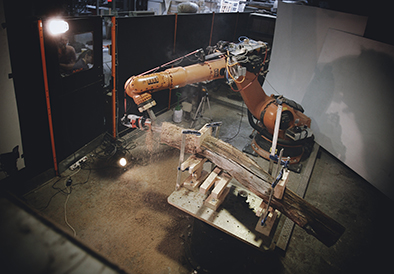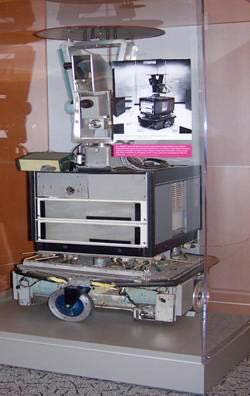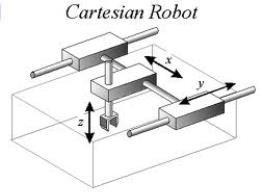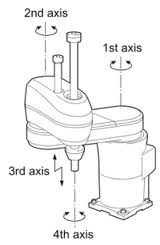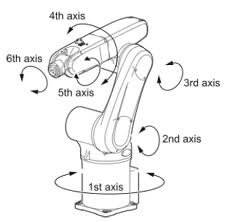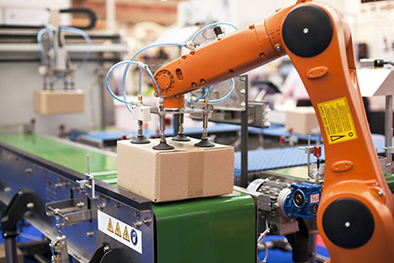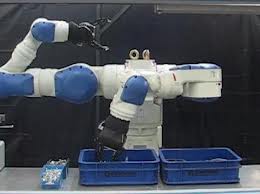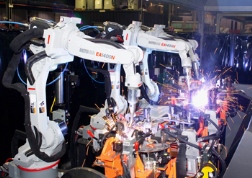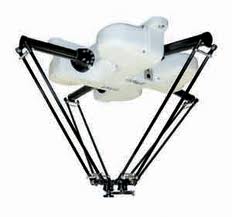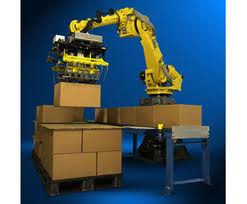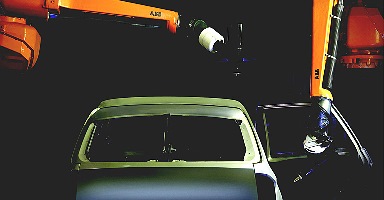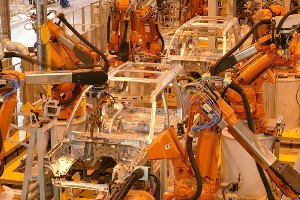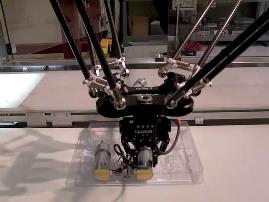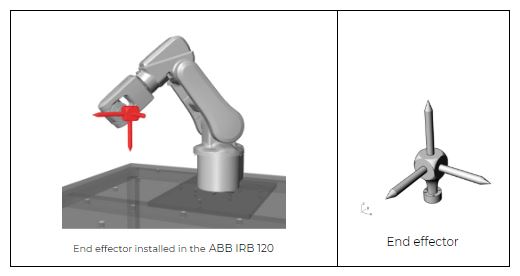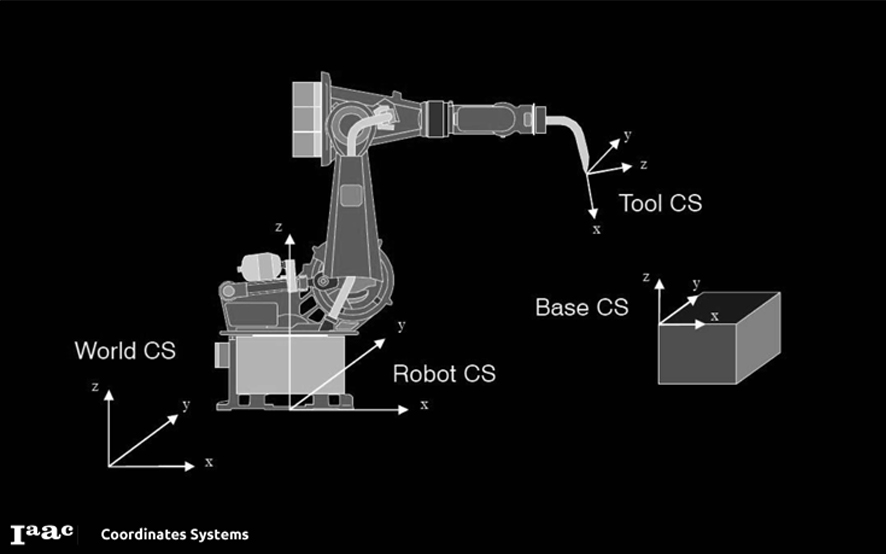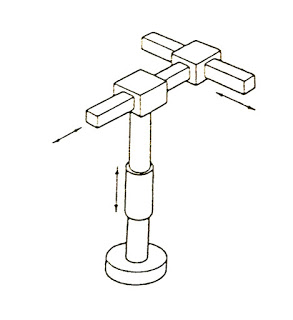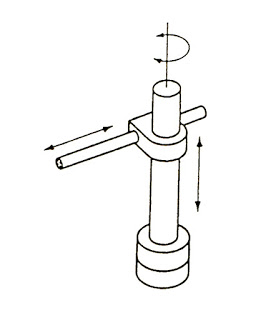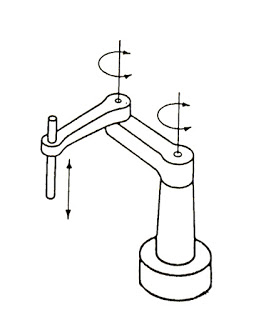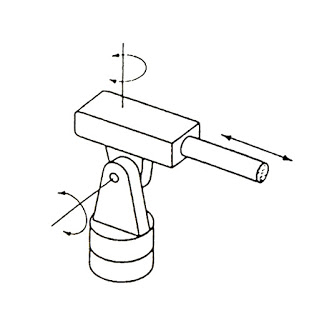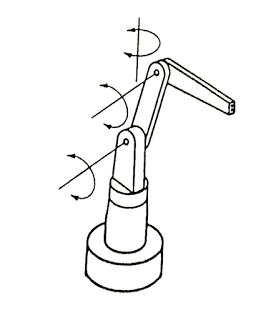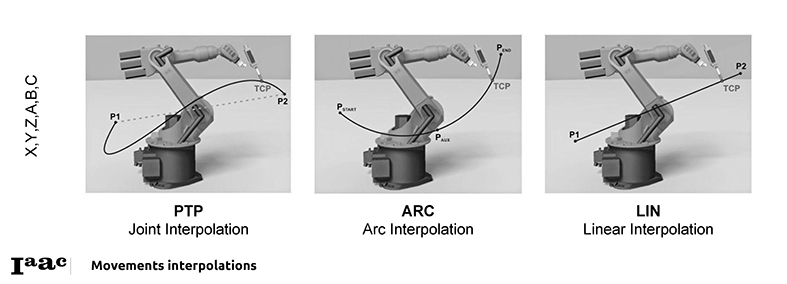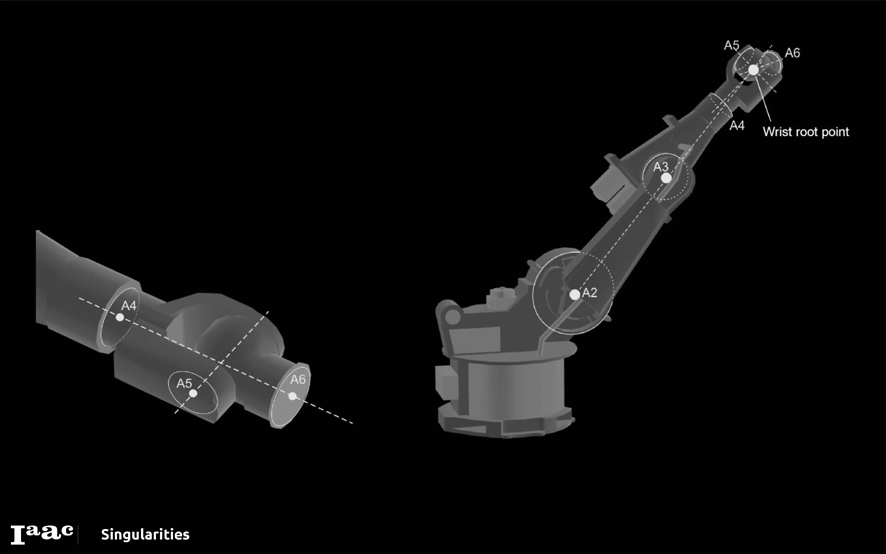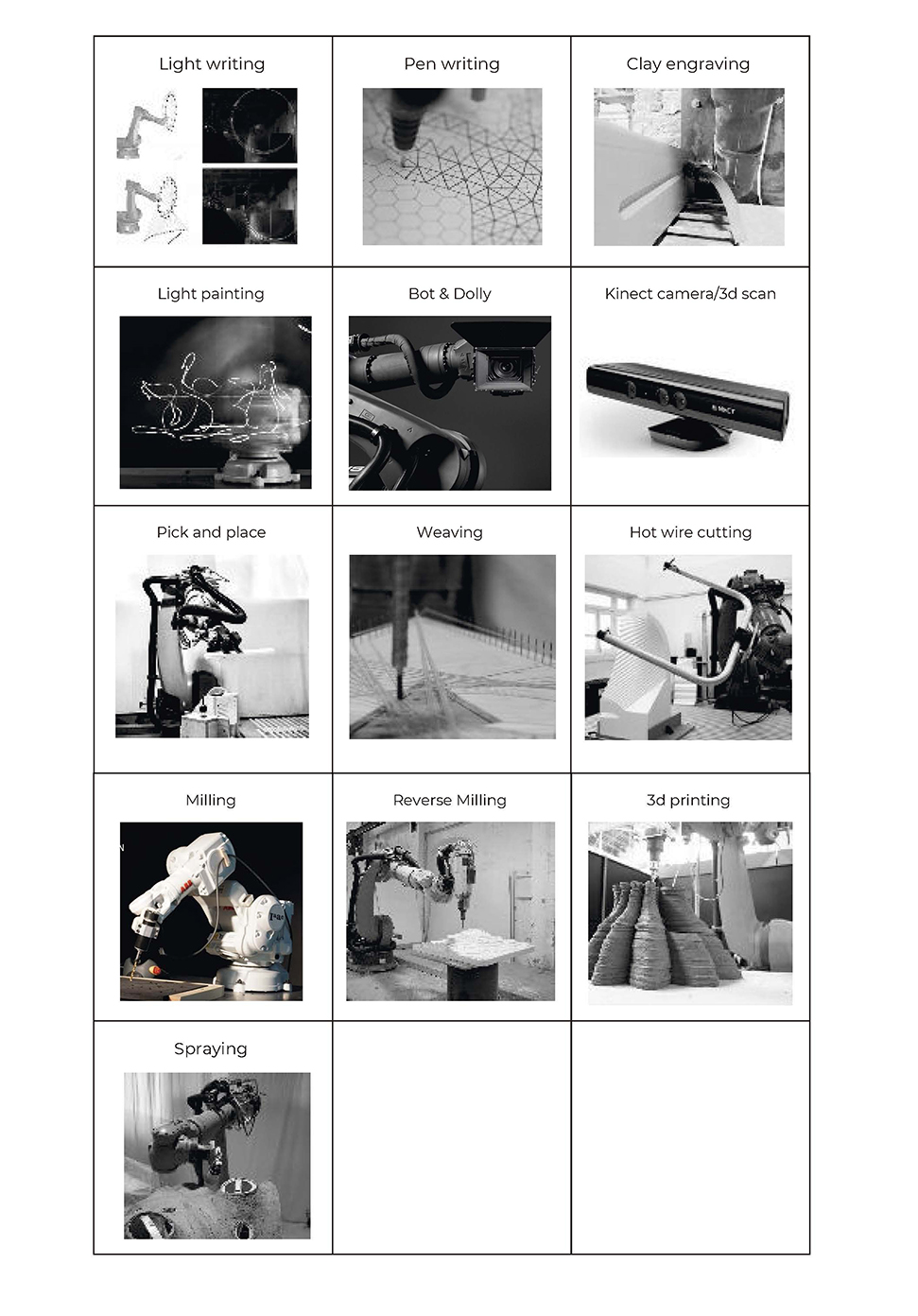Category:Robotic
Here you can find a very brief overview of robots used in manufacturing. It talks about what is it that makes a machine a robot, what differentiates the various types of robots, different ways robots can move, and three types of power sources for robots.
Iaac - Robotic fabrication workshop with Tom Pawlofsky. 2013
File:RoboFab 2018 - Robot Intro Página 02.jpg
Contents
The term Robot
Karl Capek coined the term robot in 1920. He was a Czech playwright who wrote R.U.R. which stands for Rosumovi Univerzální Roboti (Rossum’s Universal Robots).
Robots
What is a robot?
Rather than defining what a robot is right away, let's pause for a moment and discuss whether we need to answer a question like this after all. Everybody knows the hat a a robot is some sort of a machine that can move around depending on what movie you saw or which book you read, it can either help humans in their day-to-day life or mean the end of humanity. It's clear that there is some controversy and lots of misunderstandings about robots and their role in the past, present, and the future. In order to better understand the situation, let's first examine closely the term "robot" itself. Then, we will try to define it a bit more formally to prevent any misunderstanding or controversy. History of the term robot The term "robot" was used for the first time by Karel Čapek, a Czech writer in his play Rossum's Universal Robots (R.U.R) that he wrote in 1920, to denote an artificial human made out of synthetic organic matter. These robots (roboti in Czech) were made in factories and their purpose was to replace human workers. While they were very efficient and executed orders they were given perfectly, they lacked any emotion. It seemed that humans would not need to work at all because robots seemed to be happy to work for them. This changed after a while and a robot revolt result in the ed in the extinction of the human race. R.U.R is quite dark and disturbing, but it does not leave the future hopeless. It was considered quite a success back in the day and we certainly do recommend you to read it. As its copyright had already expired in many countries at the time of writing this book, it should not be a problem to find a version online, which is in the public domain.
"When he (Young Rossum) took a look at human anatomy he saw immediately that it was too complex and that a good engineer could simplify it. So he undertook to redesign anatomy, experimenting with what would lend itself to omission or simplification. Robots have a phenomenal memory. If you were to read them a twenty-volume encyclopedia they could repeat the contents in order, but they never think up anything original. They'd make fine university professors." – Karel Capek, R.U.R. (Rossum's Universal Robots), 1920
While many attribute the term robot to Karel Čapek as he wrote the play in which it appeared for the first time, there are sources suggesting that it was actually Čapek's brother Josef who came up with the term (it seems that there was an article in Czech daily print written by Karel Čapek himself, in which he wants to set the record straight by telling this story). Karel wanted to use the term laboři (from Latin labour, work), but he did not like it. It seemed too artificial to him, so he asked his brother for advice. Josef suggested robotic and that was what Karel used in the end.
Now that we know when the term robot was used for the first time and who actually created it, let's find out where does it come from. The explanation that many use is that it comes from the Czech words robota and robotník, which literally means "work" and "worker" respectively. However, the word robota also means "work" or "serf labour" in Slovak. Also, we should take into account that some sources suggest that by the time Karel was writing R.U.R, he and his brother often visited his father in a small Slovak spa town called Trenčianske Teplice. Therefore, it might very well be that the term robot was inspired by the usage of the word "robota" in the Slovak language, which is coincidental, the native language of one of the authors of this book.
Whether the term robot comes from Czech or Slovak, the word robota might be a matter of national pride, but it does not concern us too much. In both cases, the literal meaning is "work", "labour", or "hard work" and it was the purpose of the Čapek's robots. However, robots have evolved dramatically over the past hundred years. To say that they are all about doing hard work would probably be an understatement. So, let's try to define the notion of a robot as we perceive it today.
Modern definition of a robot
When we try to find a precise definition of some term, our first stop is usually some sort of encyclopedia or a dictionary. Let's try to do this for the term robot. Our first stop will be Encyclopedia Britannica. Its definition of a robot is as follows:
"Any automatically operated machine that replaces human effort, though it might not resemble human beings in appearance or perform functions in a humanlike manner."
This is quite a nice definition, but there are quite a few problems with it. First of all, it's a bit too broad. By this definition, a washing machine should also be considered a robot. It does operate automatically (well, most of them do), it does replace human effort (although not by changing the same tasks a human would do), and it certainly does not resemble a human.
Secondly, it's quite difficult to imagine what a robot actually is after reading this definition. With such a broad definition, there are way too many things that can be considered a robot and this definition do not provide us with any specific features. It turns out that while Encyclopedia Britannica's definition of a robot does not fit our needs well enough, it's actually one of the best ones that one can find. For example, The Free Dictionary defines a robot as "A mechanical device that sometimes resembles a human and is capable of performing a variety of often complex human tasks on command or by being programmed in advance."
This is even worse than what we had and it seems that a washing machine should still be considered a robot. The inherent problem with these definitions is that they try to capture a vast amount of machines that we call robots these days. The result is that it's very difficult, if not impossible, to come up with a definition that will be comprehensive enough and not include a washing machine at the same time. John Engelberger, founder of the world's first robotics company and industrial robotics (as we know it today) once famously said, "I can't define a robot, but I know one when I see one."
So, is it even possible to define a robot? Maybe not in general. However, if we limit ourselves just to the scope of this book, there may be a definition that will suit our needs well enough. In her very nice introductory book on the subject of robotics called The Robotics Primer (which we also highly recommend), Maja J. Mataric uses the following definition:
"A robot is an autonomous system which exists in the physical world, can sense its environment, and can act on it to achieve some goals."
At first sight, it might not seem like a vast improvement over what we have so far, but let's dissect it part by part to see whether it meets our needs. The first part says, "A robot is an autonomous system". By autonomous, we mean that a robot makes decisions on its own—it's not controlled by a human. This already seems to be an improvement as it weeds out any machine that's controlled by someone (such as our famous washing machine). Robots that we will talk about throughout this book may sometimes have some sort of a remote function, which allows a human to control it remotely, but this functionality is usually built-in as sort of a safety measure so that if something goes wrong and the robot's autonomous systems fail to behave as we would expect them to, it's still possible to get the robot to safety and diagnose its problems afterwards. However, the main goal still stays the same, that is, to build robots that can take some direction from humans and are able to act and function on their own. However, just being an autonomous system will certainly not be enough for a robot in this book. For instance, we can find many computer programs that we can call autonomous systems (they are not controlled by an individual and make decisions on their own) and yet we do not consider them to be robots. To get around this obstacle, we need the other part of the sentence that says, "which exists in the physical world".
Given the recent advances in the fields of artificial intelligence and machine learning, there is no shortage of computer systems that act on their own and perform some work for us, which is what robots should be for. As a quite notorious example, let's consider spam filters. These are computer programs that read every e-mail that reaches your e-mail address and decides whether you may want to read it (and that the e-mail is indeed legitimate) or whether it's yet another example of an unwanted e-mail.
There is no doubt that such a system is helpful (if you disagree, try to read some of the e-mails in your Spam folder—I am pretty sure it will be a boring read). It's estimated that over 60 per cent of all e-mail traffic in 2014 can be attributed to spam e-mails. Being able to automatically filter them can save us a lot of reading time. Also, as there is no human involved in the decision process (although, we can help it by marking an e-mail as spam), we can call such a system as autonomous. Still, we will not call it a true robot. Rather, we call them "software robots" or just "bots" (the fact that their name is shorter may come from the fact that they are short of the physical parts of true robots).
While software robots are definitely an interesting group on its own, it's the physical world in which robots operate that makes the process of creating them so exciting and difficult at the same time. When creating a software robot, you can count on the fact that the environment it will run in (usually the operating system) will be quite stable (as in, not too many things may change unexpectedly). However, when you are creating a real robot, you can never be sure. This is why a real robot needs to know what is happening in the environment in which it operates. Also, this is why the next part of the definition says, "can sense its environment".
Sensing what is happening around a real robot is arguably its most important feature. To sense their surrounding environments, robots usually have sensors. These are devices that measure physical characteristics of the environment and provide this information back to the robot so that it can, for instance, react to sudden changes of temperature, humidity, or pressure. This is quite a big difference from software robots. While they just get the information they need in order to operate somewhat magically, real robots need to have a subsystem or subsystems that take care of obtaining this information. If we look at the differences between robots and humans, we will not find many (in our very high-level view, of course). We can think of sensor subsystems as artificial replacements for human organs that provide this sort of information to the brain.
One important consequence of this definition is that anything that does not sense its environment cannot be called a robot. This includes any devices that just "drive blind" or move in a random fashion because they do not have any information from the environment to base their behaviour on. Any roboticist will tell you that robots are very exciting machines. Many will also, argue that what makes them so exciting is actually their ability to interact with the outside world (which is to move or otherwise change the environment they are in). Without this, they are just another static machine that might be useful, but rather unexciting.
Our definition of a robot reflects this in its last part when it says, "can act on it to achieve some goals".
Acting on the environment might sound like a very complex task for a robot, but in this case, it just means changing the world in some (even very slight) way. We call these parts of robots that perform this as effectors. If we look at our robot vs human comparison, effectors are the artificial equivalents of hands, legs, and other body parts that allow it to move. Effectors make use of some lower-level systems such as motors or muscles that actually carry out the movement. We call them actuators. Although, the artificial ones may seem to function similar to the biological ones, a closer look will reveal that they are actually quite different. You may have noticed that this part is not only about acting on the robot's environment, but also about achieving some goals. While many hobby roboticists build robots just for the fun of it, most robots are built in order to carry out (or, should we rather say, to help with) some tasks, such as moving heavy parts in a factory or locating victims in areas affected by natural disasters.
As we said before, a system or a machine that behaves randomly and does not use information from its environment cannot really be considered a robot. However, how can it use this information somehow? The easiest thing to do is to do something useful, which we can rephrase as trying to reach some goal that we consider useful, which in turn brings us back to our definition. A goal of a robot does not necessarily need to be something as complex and ambitious as "hard labour for human". It can easily be something simple, such as "do not bump into obstacles" or "turn the light switch on".
Now, as we have at least a slight idea of what a robot is, we can move on to briefly discuss where robots come from, in other words, the history of robotics.
Where do robots come from?
As the title suggests, this part of the chapter should be about the history of robots. We already know a few quite important facts, such as the term robot was coined by a Czech author Karel Čapek in 1920. As it turns out, there are many more interesting events that happened over the years, other than this one. In order to keep things organized, let's start from the beginning.
It's quite difficult to pinpoint a precise date in history, which we can mark as the date of birth of the first robot. For one, we have established quite a restrictive definition of a robot previously; thus, we will have to wait until the 20th century to actually see a robot in the proper sense of the word. Until then, let's at least discuss the honourable mentions.
The first one that comes close to a robot is a mechanical bird called "The Pigeon". This was postulated by a Greek mathematician Archytas of Tarentum in the 4th century BC and was supposed to be propelled by steam. It cannot be considered a robot by our definition (not being able to sense its environment already disqualifies it), but it comes pretty comes for its age. Over the following centuries, there were many attempts to create automatic machines, such as clocks measuring time using the flow of water, life-sized mechanical figures, or even first programmable humanoid robots (it was actually a boat with four automatic musicians on it). The problem with all these is that they are very disputable as there is very little (or none) historically trustworthy information available about these machines.
It would have stayed like this for quite some time if it was not for Leonardo Da Vinci's notebooks that were rediscovered in the 1950s. They contain a complete drawing of a 1945 humanoid (a fancy word for a mechanical device that resembles humans), which looks like an armoured knight. It seems that it was designed so that it could sit up, wave its arms, move its head, and most importantly, amuse royalty. In the 18th century, following the amusement line, Jacques de Vaucanson created three automata: a flute player that could play twelve songs, a tambourine player, and the most famous one, "The Digesting Duck". This duck was capable of moving, quacking, flapping wings, or even eating and digesting food (not in a way you will probably think—it just released matter stored in a hidden compartment). It was an example of "moving anatomy"—modeling human or animal anatomy using mechanics.
Our list will not be complete if we omitted these robot-like devices that came about in the following century. Many of them were radio-controlled, such as Nikola Tesla's boat, which he showcased at Madison Square Garden in New York. You could command it to go forward, stop, turn left or right, turn its lights on or off, and even submerge. All of this did not seem too impressive at that time because the press reports attributed it to "mind control".
At this point, we have once again reached the time when the term robot was used for the first time. As we said many times before, it was in 1920 when Karel Čapek used it in his play, R.U.R. Two decades later, another very important term was coined. Issac Asimov used the term robotics for the first time in his story "Runaround" in 1942. Asimov wrote many other stories about robots and is considered to be a prominent sci-fi author of his time.
However, in the world of robotics, he is known for his three laws of robotics:
• First law: A robot may not injure a human being or through inaction allow a human being to come to harm.
• Second Law: A robot must obey the orders given to it by human beings, except where such orders would conflict with the first law.
• Third law: A robot must protect its own existence, as long as such protection does not conflict with the first or second law.
After a while, he added a zeroth law:
• Zeroth law: A robot may not harm humanity or by inaction allow humanity to come to harm.
These laws somehow reflect the feelings people had about machines they called robots at that time. Seeing enslavement by some sort of intelligent machine as a real possibility, these laws were supposed to be some sort of guiding principles one should at least keep in mind, if not directly follow when designing a new intelligent machine. Also, while many were afraid of the robot apocalypse, the time has shown that it's still yet to come. In order for it to take place, machines will need to get some sort of intelligence, some ability to think and act based on their thoughts. Also, while we can see that over the course of history, the mechanical side of robots went through some development, the intelligence simply was not there yet. This was part of the reason why in the summer of 1956, a group of very wise gentlemen (which included Marvin Minsky, John McCarthy, Herbert Simon, and Allan Newell) was later called to be the founding fathers of the newly founded field of Artificial Intelligence. It was at this very event where they got together to discuss creating intelligence in machines (thus, the term artificial intelligence).
Although, their goals were very ambitious (some sources even mention that their idea was to build this whole machine intelligence during that summer), it took quite a while until some interesting results could be presented. One such example is Shakey, a robot built by the Stanford Research Institute (SRI) in 1966. It was the first robot (in our modern sense of the word) capable to reason its own actions. The robots built before this usually had all the actions they could execute preprogrammed. On the other hand, Shakey was able to analyze a more complex command and split it into smaller problems on his own.
The following image of Shakey is taken from https://en.wikipedia.org/wiki/ File:ShakeyLivesHere.jpg:
Shakey, resting in the Computer History Museum in Mountain View, California
His hardware was quite advanced too. He had collision detectors, sonar range finders, and a television camera. He operated in a small closed environment of rooms, which were usually filled with obstacles of many kinds. In order to navigate around these obstacles, it was necessary to find a way around these obstacles while not bumping into something. Shakey did it in a very straightforward way.
At first, he carefully planned his moves around these obstacles and slowly (the technology was not as advanced back then) tried to move around them. Of course, getting from a stable position to movement wouldn't be possible without some shaky moves. The problem was that Shakey's movements were mostly of this shakey nature, so he could not be called anything other than Shakey. The lessons learned by the researchers who were trying to teach Shakey how to navigate in his environment turned out to be very important. It comes as no surprise that one of the results of the research on Shakey is the A* search algorithm (an algorithm that can very efficiently find the best path between two goals). This is considered to be one of the most fundamental building blocks not only in the field of robotics or artificial intelligence but also in the field of computer science as a whole. Our discussion on the history of robotics can go on and on for a very long time. Although one can definitely write a book on this topic (as it's a very interesting one), it's not this book; we shall try to get back to the question we tried to answer, which was: where do robots come from?
In a nutshell, robots evolved from the very basic mechanical automation through remotely-controlled objects to devices or systems that can act (or even adopt) on their own in order to achieve some goal. If this sounds way too complicated, do not worry. The truth is that to build your own robot, you do not really need to deeply understand any of this. The vast majority of robots you will encounter are built from simple parts that are not difficult to understand when you see the big picture. So, let's figure out how we will build our own robot. Let's find out what are the robots made of.
What can we find in a robot?
In the very first part of this chapter, we tried to come up with a good (modern) definition of a robot. It turns out that the definition we came up with does not only describe a robot as we know it (or would like to know it), but also gives us some great pointers as to what parts can we most definitely find in (or on) a robot. Let's see our definition again: "A robot is an autonomous system which exists in the physical world, can sense its environment, and can act on it to achieve some goals." So, what will these most important parts be? Here is what we think should be on this list.
Industrial robots with different types of movements
Cartesian robots Cartesian robots are robots that can do 3 translations using linear slides.
SCARA robots Scara robots are robots that can do 3 translations plus a rotation around a vertical axis.
6-axis robots 6-axis robots are robots that can fully position their tool in a given position (3 translations) and orientation (3 orientations)
Redundant robots Redundant robots can also fully position their tool in a given position. But while 6-axis robots can only have one posture for one given tool position, redundant robots can accommodate a given tool position under different postures. This is just like the human arm that can hold a fixed handle while moving the shoulder and elbow joints.
Dual-arm robots Dual-arm robots are composed of two arms that can work together on a given workpiece.
The type of movement is dictated by the arrangement of joints (placement and type) and linkages.
Industrial robots for different applications
The application is the type of work that the robot is designed to do. Robot models are created with specific applications or processes in mind. Different applications will have different requirements. For instance, a painting robot will require a small payload but a large movement range and be explosion proof. On the other hand, an assembly robot will have a small workspace but will be very precise and fast. Depending on the target application, the industrial robot will have a specific type of movement, linkage dimension, control law, software and accessory packages. Below are some types of applications:
Welding robots
Material handling robots
palletizing robot
Painting robot
Assembly robot
Serial or parallel industrial robots Serial robots are the most common. They are composed of a series of joints and linkages that go from the base to the robot tool.
Parallel robots come in many forms. Some call to them spiders robots. Parallel industrial robots are made in such a way that you can close loops from the base, to the tool and back to the base again. It's like many arms working together with the robot tool. Parallel industrial robots typically have a smaller workspace (try to move your arms around while holding your hands together vs the space you can reach with a free arm) but higher accelerations, as the actuators don't need to be moved: they all sit at the base.
The latest generation: Collaborative industrial robots
There is a new qualifier that has just recently been used to classify an industrial robot, that is to say if it can collaborate with its human co-workers. Collaborative robots are made in such a way that they respect some safety standards so that they cannot hurt a human. While traditional industrial robots generally need to be fenced off away from human co-workers for safety reasons. Collaborative robots can be used in the same environment as humans. They can also usually be taught instead of programmed by an operator. Examples of collaborative robots are:
ABB https://new.abb.com/products/robotics
KUKA https://www.kuka.com/en-de
Rethink Robotics Sawyer & Baxter [1]
Universal Robots UR3, UR5 & UR10 https://blog.robotiq.com/bid/61616/Robot-Gripper-for-Universal-Robots
Basic terminologies
Work Cell: All the equipment needed to perform the robotic process (robot, table, fixtures, etc.)
Work Envelope: All the space the robot can reach.
Degrees of Freedom: The number of movable motions in the robot. To be considered a robot there needs to be a minimum of 4 degrees of freedom. The Kuka Agilus robots have 6 degrees of freedom.
Payload: The amount of weight a robot can handle at full arm extension and moving at full speed.
End Effector: The tool that does the work of the robot. Examples: Welding gun, paint gun, gripper, etc.
Manipulator: The robot arm (everything except the End of Arm Tooling).
TCP: Tool Center Point. This is the point (coordinate) that we program in relation to.
Positioning Axes: The first three axes of the robot (1, 2, 3). Base / Shoulder / Elbow = Positioning Axes. These are the axes near the base of the robot.
Orientation Axes: The other joints (4, 5, 6). These joints are always rotary. Pitch / Roll / Yaw = Orientation Axes. These are the axes closer to the tool.
Coordinates Systems
Classification
Industrial robots can be classified into six categories based on the following characteristics:
Degrees of Freedom Arm Geometry Power Source Types of Motion Path Control Intelligence
Degrees of Freedom
The number of movable motions in a robot defines its degrees of freedom. In articulated robots such as those in the Fab Lab have at least 6 degrees of freedom. These joints, or axes, are broken into two categories. The three joints nearest the base of the manipulator are called the positioning axes. The three closest to the tool are called the orientation axes. Robots can have larger degrees of freedom by having external axes, for instance, the entire robot can be mounted on a sledge which moves along a track. This would be the seventh degree of freedom.
Arm geometry
The arm geometry, that is the configuration and type of joints used, determines the shape of the work envelope.
Rectangular (Cartesian) The work envelope is a box. All three axes are linear.
Cylindrical
The work envelope is a cylinder. Axis 1 is rotary. Other axes are linear.
SCARA This is a variation of a cylindrical work envelope robot. SCARA is an acronym for Selective Compliance Articulated Robot Arm. Joints 1 and 2 of this type are rotary and in the same plane. Joint 3 is linear. These are often called Pick and Place robots.
Spherical
This type of arm geometry produces a ball-shaped work envelope.
Axes 1 and 2 are rotary. Axis 3 is linear.
Articulated This type of arm geometry, which is what we use in the Fab Lab is also referred to as Jointed Spherical.
Types of Motion
Robot Programming allows us to develop several motion types:
- PTP: POINT TO POINT
The robot guides the TCP along the fastest path to the endpoint. The fastest path is generally not the shortest path and is thus not a straight line. As the motions of the robot axes are rotational, curved paths can be executed faster than straight paths. The exact path of the motion cannot be predicted.
- CIRC: Circular
The robot guides the TCP at a defined velocity along a circular path to the endpoint. The circular path is defined by a start point, auxiliary point and endpoint.
- LIN: Linear
The robot guides the TCP at a defined velocity along a straight path to the end point. This path is predictable.
Singularities
This is a condition in which the manipulator loses one or more degrees of freedom and change in joint variables does not result in change in end effector location and orientation variables. This is a case when the determinant of the Jacobian matrix is zero ie. It is a rank deficit.
Intuitively, Singularities play a significant role in the design and control of robot manipulators. Singularities of the kinematic mapping, which determines the position of the end–effector in terms of the manipulator’s joint variables, may impede control algorithms, lead to large joint velocities, forces and torques and reduce instantaneous mobility.
However they can also enable fine control, and the singularities exhibited by trajectories of the points in the end–effector can be used to mechanical advantage. A number of attempts have been made to understand kinematic singularities and, more specifically, singularities of robot manipulators, using aspects of the singularity theory of smooth maps.
Power source
The three most common method of powering robots are air pressure (pneumatic), fluid pressure (hydraulics) and electricity. The main characteristics of each of these methods are listed below:
Pneumatic
Weakest Fastest Clean Inexpensive Low Tech Open loop (non-servo) Stop-to-stop for path control Uses hard-stops determine program locations Loud - referred to as "bang bang" robots
Hydraulic
Most powerful (greatest payload) Messy to repair Closed loop (servo) More flexible than pneumatic Mid-range in noise Oil used can contaminate paints Most expensive (have to buy both hydraulic and electronic systems) Most costly to repair (have to fix both hydraulic and electronic systems)
Electric
Most popular Clean Quiet Closed loop (servo motors) Most flexible Can use sealed motors for painting
Robotic Processes
To make working with robots easier for everybody, the Iaac Atelier Lab has divided the workflow into two groups: Existing Robotic processes and New Robotic processes. The existing robotic processes are processes which have been tested in the recent past, which means they can be easily accessed but still have to be checked with the lab about their current usage. New robotic process is techniques still not developed / in process, so they might need extra support for setting up. It is to be considered that they would need additional time for calibration.
Following are the Existing Robotic Processes :
All this information is coming from:
Alexandre Dubor,
Kunal Chadha,
Ricardo Mayor Luque
and many people at IAAC
Learning Robotics Using Python, Lentin Joseph. Packt Publishing Ltd, May 27, 2015.
Singularities of Robot Manipulators. Peter Donelan
and http://mkmra2.blogspot.com/
This category currently contains no pages or media.
